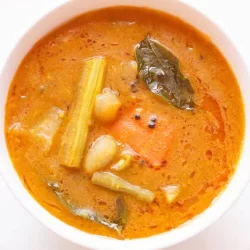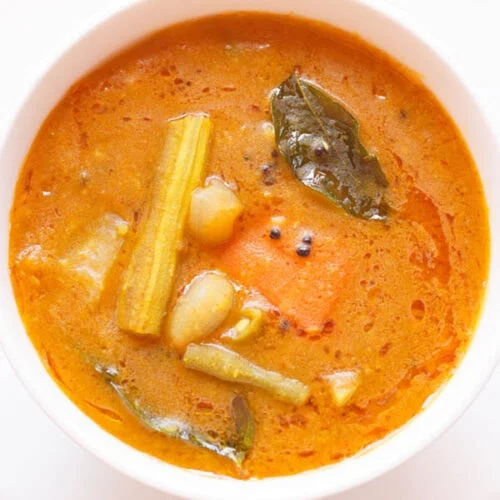
Sambar Recipe | Authentic South Indian Sambar Recipe
I present to you our cherished Sambar Recipe, a culinary masterpiece that I've honed through time. Craft this delectable, wholesome, and nourishing South Indian stew using the uncomplicated technique provided. Indulge in the sambar alongside traditional South Indian treats such as idli, dosa, uttapam, medu vada, or harmonize it with rice for a satisfying, well-balanced, and comforting repast.
Ingredients
For Tamarind Pulp
- 1 tablespoon tamarind
- ⅓ cup hot water
For Cooking Dal
- ½ cup tur dal or arhar dal (pigeon pea lentils) – 100 grams
- ¼ teaspoon turmeric powder (ground turmeric)
- 1.5 to 1.75 cups water or add as required
For Cooking Vegetables
- 1 to 1.5 cups chopped vegetables like okra, french beans, potatoes, small round brinjals, pumpkin
- 1 to 2 drumsticks – scraped and chopped in 3 to 4 inches sticks.
- 6 to 7 pearl onions (sambar onions) or 1 small to medium onion, thickly sliced
- 1 tomato – small to medium, quartered or diced
- ¼ teaspoon turmeric powder (ground turmeric)
- ½ teaspoon kashmiri red chilli powder – optional
- salt as required
- 1.5 to 2 cups water or add as required
For Tempering
- 2 tablespoons sesame oil (gingelly oil), can also use coconut oil or sunflower oil or ghee
- ½ teaspoon mustard seeds
- 1 to 2 dry red chillies – halved and seeds removed
- 10 to 12 curry leaves
- 2 pinch asafoetida (hing)
- 5 to 6 fenugreek seeds (methi seeds) – optional
For Garnish
- 1 tablespoon chopped coriander leaves (cilantro) – optional
Instructions
Making Tamarind Pulp
- Soak the tamarind in hot water for 20 to 30 minutes.
- Once the tamarind gets soft, then squeeze the tamarind in the water itself. Discard the strained tamarind and keep the tamarind pulp aside.
Cooking Lentils
- Rinse tuvar dal a couple of times in water.
- Drain all the water and add the dal in a 2 litre pressure cooker. Also add ¼ teaspoon turmeric powder.
- Add 1.5 to 1.75 cups water and mix. Cover and pressure cook dal for 7 to 8 whistles or 9 to 10 minutes on medium heat.
- When the pressure settles down on its own, open the lid and check the dal. The dal should be completely cooked and mushy.
- Mash the dal with a spoon or wired whisk. Cover and keep aside. You can see the consistency of dal in the pic below.
Cooking Vegetables
- When the dal is pressure cooking – rinse, peel and chop the vegetables.
- Take the chopped vegetables in a pan or pot. Also add 6 to 7 pearl onions or 1 small to medium onion (thickly sliced) and 1 small to medium tomato (quartered).
- Sprinkle turmeric powder, kashmiri red chilli powder and salt as per taste. Adding kashmiri red chili powder is optional and can be skipped.
- Add 1.5 to 2 cups water and stir.
- Keep the pan on a stove top and begin to cook vegetables on a medium-low to medium flame. In between do check when the vegetables are cooking.
- Cook till the vegetables are almost done. Ensure that you don’t over cook the vegetables.
Making Sambar
- Once the vegetables are almost cooked, then add the tamarind pulp and 1 to 1.5 tablespoons sambar powder. Mix well.
- Add the mashed dal. Mix again very well.
- Simmer on a medium-low heat till the sambar comes to a boil.
- You will see a frothy layer on top when the sambar begins boiling. At this step switch off the heat. Cover and set aside.
Tempering
- In a small pan or tadka pan, heat 2 tablespoons gingelly oil. Add ½ tsp mustard seeds.
- Let the mustard seeds crackle.
- Then add 1 to 2 dry red chillies (halved and seeds removed).
- Immediately add 10 to 12 curry leaves, 5 to 6 methi seeds and 2 pinches of asafoetida (hing). Be careful as the oil splutters while adding curry leaves.
- Fry them till the red chilies change color and curry leaves become crisp.
- Immediately add this tempering mixture in the hot sambar.
- Cover the pan with its lid for 4 to 5 minutes, so that the aroma and flavors from the tempering mixture gets infused with the sambar.
- Serve sambar hot. You can garnish it with a few coriander leaves if you prefer. It can also be served with steamed rice, idli, dosa, medu vada or uttapam.
Serving Suggestions
- Serve sambar with steamed rice, idli, dosa or medu vadai or uttapam.
- Vary the consistency of sambar keeping in mind the dish you want to serve it with. Example – a medium to slightly thin sambar is served with idli, dosa and medu vada. Sambar with a medium to thick consistency is served with steamed rice.
Storage And Leftovers
- Store any leftovers in the refrigerator for a day only. Note that the consistency will thicken after refrigeration. Add some water and mix to get your desired consistency while reheating in a pan.
Nutrition
Calories: 265kcalCarbohydrates: 38gProtein: 11gFat: 8gSaturated Fat: 1gSodium: 60mgPotassium: 700mgFiber: 13gSugar: 8gVitamin A: 4125IUVitamin C: 108.7mgCalcium: 81mgIron: 4.1mg
Tried this recipe?Let us know how it was!

